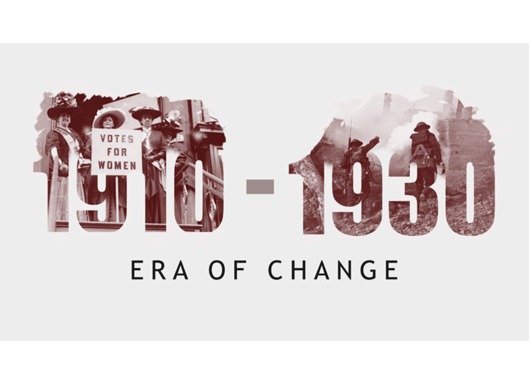Era of Change

A history through objects from Broome County’s past.
Beautifully curated artifacts within the Era of Change exhibition guide visitors through a story of events, advancements, and issues between 1910 and 1930. Women’s suffrage, advancements in advertising, radio, and film, prohibition, labor, immigration, and war to name a few.
A lot of people asked for change in these two decades. When browsing through this exhibition ask your self, “What change was made and what changes are we still asking for?”
Closing May 17, 2021
Summary:
We begin in 1910: America was on the verge of dramatic change. Immigration had peaked, with 8.8 million people entering the United States between 1901 and 1910. By 1915 nativism was rising, and new restrictions on immigration were gaining ground. The country would enter World War I in seven years, emerging a world power by war’s end. African Americans began a “Great Migration” to big northern cities, seeking better lives than the ones they left down south. The Ku Klux Klan rose again in reaction to cultural changes of the time. New inventions changed the way people lived, traveled, worked and played. Incomes increased in what would be an era of prosperity for some. American women would soon gain the right to vote, and scores would exchange their long skirts and prim shirtwaists for short slinky dresses and bobbed hair. Prohibition was lurking, and “bootlegger, bathtub gin” and “speakeasy” would become household words.
Then we move into the “Roaring Twenties,” which had come in like a lion, as new technologies were producing new goods to be sold to a wealthier public. Many now owned cars, radios, vacuum cleaners, washing machines and refrigerators. In a post-war frenzy, people began borrowing money to buy stocks, believing the economy would boom forever. When the market crashed on October 23, 1929, the Roaring Twenties went out like a lamb to slaughter, plunging America into the Great Depression.
Swept along in the tide of change, Broome County thrived in this era. The population grew and diversified, some industries fell while others rose, women went to the polls for the first time, and the automobile replaced the horse and buggy. Broome County played its part in World War I. Close to 13,000 residents served, 222 of whom died doing so. The county also saw the rise of illegal stills and speakeasies with the passage of the Eighteenth Amendment in 1919. By 1930, Broome County reflected nationwide changes in society — new home conveniences, fashions, entertainments, industries, and a new morality.
Support for this exhibition is provided by the general operations support grants from the United Cultural Fund, a program of the Broome County Arts Council; the Conrad and Virginia Klee Foundation; the Zoos, Botanical Gardens and Aquariums Program, administered by the New York State Office of Parks, Recreational, and Historical Preservation; and the New York State Council for the Arts with the support of Governor Andrew M. Cuomo and the New York State Legislature.



